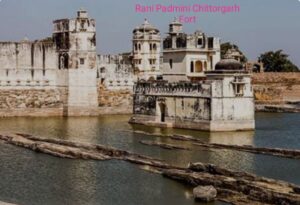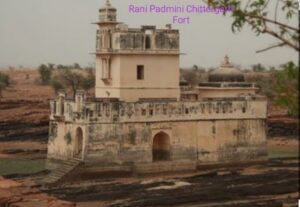Rani Padmini Chittorgarh Fort, perched atop a hill in the Indian state of Rajasthan, is not only a marvel of ancient architecture but also a symbol of bravery, sacrifice, and honor. Among the many tales associated with this fort, the story of Rani Padmini stands out as a beacon of courage and steadfastness. This blog delves into the historical significance of Chittorgarh Fort and the legendary saga of Rani Padmini, illuminating their pivotal roles in Indian history.

1.History of Rani Padmini Chittorgarh Fort
Chittorgarh Fort, one of the largest forts in India, was built in the 7th century by the Mauryan rulers. It served as the capital of Mewar and witnessed numerous battles, making it a vital site in the annals of Indian history. The fort’s massive walls, spanning approximately 13 kilometers, and its strategic location atop a 180-meter-high hill made it a formidable stronghold.
Over the centuries, the fort has seen many sieges and battles. It was the epicenter of three major sieges, the most notable being the one led by Alauddin Khilji in 1303. The fort’s resilience and the valiant defense put up by its inhabitants have made it a symbol of Rajput bravery and honor.
2. Rani Padmini: The Legend
Rani Padmini, also known as Padmavati, was the queen of Chittorgarh and the wife of King Ratan Singh. Renowned for her beauty and intellect, Rani Padmini’s story is a mix of historical facts and folklore, immortalized in various literary works and folklore.
The legend of Rani Padmini is intrinsically tied to the siege of Chittorgarh by Alauddin Khilji. Mesmerized by tales of her beauty, Khilji laid siege to the fort, determined to capture her. The ensuing events highlight her courage and the unyielding spirit of the Rajputs.

3.The Siege of Chittorgarh
In 1303, Alauddin Khilji, the Sultan of Delhi, led a massive army to Chittorgarh, driven by his obsession with Rani Padmini. Despite the fort’s formidable defenses, the relentless assault by Khilji’s forces eventually breached its walls. King Ratan Singh and his warriors fought valiantly, but the overwhelming strength of Khilji’s army was insurmountable.
Rani Padmini played a crucial role during this siege. She orchestrated a clever ruse to allow her husband to escape from Khilji’s captivity, demonstrating her sharp intellect and leadership. However, as defeat became inevitable, she made a decision that etched her name in history.
4.Jauhar: The Ultimate Sacrifice
Facing the prospect of capture and dishonor, Rani Padmini and the women of Chittorgarh chose to commit Jauhar, an ancient Rajput practice of self-immolation. This act of mass self-sacrifice was performed to protect their honor from the invaders. The flames of Jauhar consumed Rani Padmini and thousands of women, turning their martyrdom into a powerful symbol of resistance and valor.
The practice of Jauhar, though tragic, has significant historical and cultural implications. It underscores the Rajput code of honor and the lengths to which they would go to uphold their dignity and sovereignty.
5. Architectural Marvels of Chittorgarh Fort
Chittorgarh Fort is not only significant for its historical events but also for its architectural splendor. The fort houses several palaces, temples, and towers, each narrating a part of its rich history. Notable structures include the Vijay Stambh (Victory Tower), Kirti Stambh (Tower of Fame), and Rana Kumbha Palace.
Rani Padmini’s Palace, situated near a lotus pool, is one of the most visited sites within the fort. Though modest in size compared to other structures, it holds immense historical value. The palace’s architecture reflects the aesthetics of the period and offers a glimpse into the life of the legendary queen.
6. Cultural Significance and Legacy
Rani Padmini’s story has transcended generations, becoming an integral part of Indian culture and folklore. Her tale is celebrated in various forms of art, literature, and cinema, highlighting her bravery and the tragic grandeur of her sacrifice. The fort itself is a living testament to the valor of the Rajputs and the legacy of their indomitable spirit.
Annual festivals and events at Chittorgarh Fort celebrate this rich heritage, drawing visitors from across the world. These celebrations keep the legacy of Rani Padmini and the fort alive, fostering a deeper understanding of their historical significance.
7.Tourism and Visiting Chittorgarh Fort
Today, Chittorgarh Fort is a prominent tourist destination, attracting history enthusiasts and travelers alike. The fort’s sprawling expanse, coupled with its architectural beauty and historical importance, makes it a must-visit site.
Visitors are advised to explore the fort during the cooler months, from October to March, to fully appreciate its grandeur. Key attractions include the palaces, the intricate carvings of the towers, and the panoramic views from the fort’s ramparts. Guided tours are available, offering in-depth insights into the fort’s history and the tales of heroism associated with it.
Preserving this heritage site is crucial. Efforts are being made to maintain the fort’s structures and promote sustainable tourism to ensure that future generations can witness and appreciate its historical grandeur.
Conclusion:
Rani Padmini’s story and the history of Chittorgarh Fort are testaments to the enduring spirit of bravery and sacrifice. The fort stands as a symbol of Rajput honor, while Rani Padmini’s legacy continues to inspire. Visiting Chittorgarh Fort is not just a journey into the past but also an homage to the valor that shaped India’s history. Explore, learn, and honor the tales of courage that echo through the walls of Chittorgarh Fort.
FAQ:
1.Who was the queen of Chittorgarh fort?
2.Did Alauddin Khilji ever see Padmavati?
3.Is the Padmavati story real?
4.Rani Padmavati real photo
5.Rani Padmavati real story
6.At what age Rani Padmavati died
7.Rani Padmavati husband name
8.Rani Padmavati jauhar with How many ladies
9.Where did Rani Padmavati died

